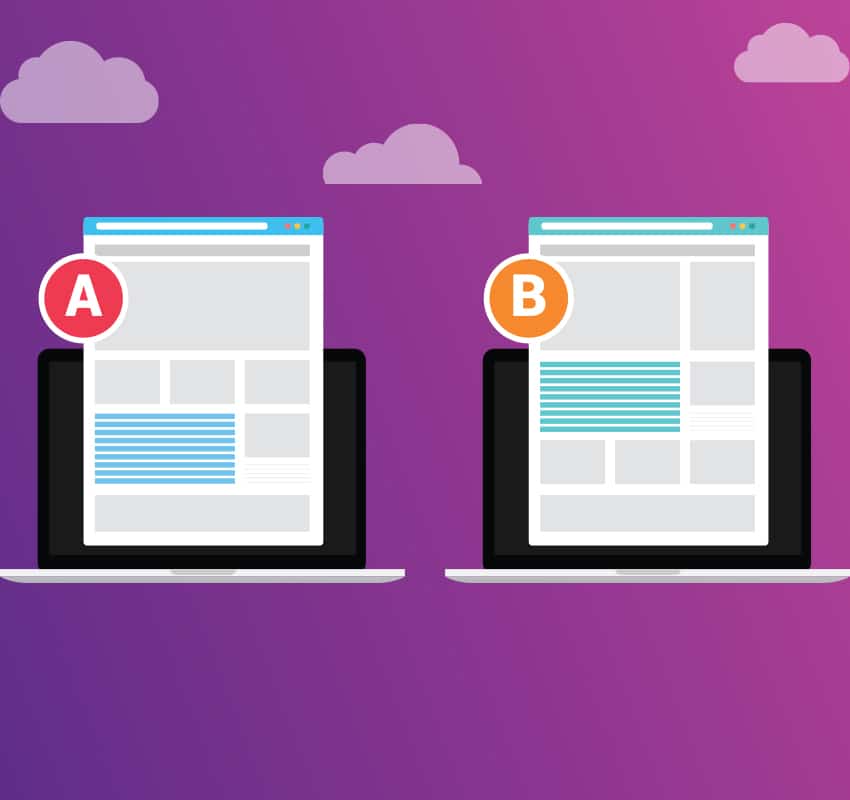What is A/B Testing? A Practical Guide With Examples
Despite sharing the same genetic makeup, identical twins always end up with lives different from one another. Why is that? Well, while they do have the same physical traits and DNA, their lives are shaped by the multitude of little decisions they make. Those small variations in lifestyle, choices, and environment often result in big differences.
What is A/B Testing
A/B testing, sometimes referred to as split testing, is a methodology used in marketing to improve campaign performance. It involves creating two or more versions of a given piece of content, running them in front of selected audiences, and analyzing the performance of each to determine which did better and why. The ultimate goal of A/B testing guide is to fully understand how a campaign performs in the real world and what factors can be changed to ensure its ultimate success.
In the world of advertising, it’s essential to ensure that your commercials are successful and efficiently reaching your target audience. One way to achieve this is through Ad testing services, which give businesses insightful information on the effectiveness of their commercials. A/B testing is heavily relied upon by marketers and advertisers as a means of improving their content before going all-in on a fully-fledged campaign. It eliminates the guesswork involved in maximizing ROI. A randomized experiment employing two or more variations of the same web page is known as an A/B test.
It involves altering a webpage or app screen to produce a second version of the same page. A single headline, button, or a whole page redesign can all be included in this modification. Then, half of your visitors see the page’s updated version and the other half sees the original version (known as the control) (the variation)
How A/B Testing Works
The ‘A’ and ‘B’ in A/B testing refer to the method’s approach to comparing content, where ‘A’ represents the original copy, and ‘B’ signifies its variation. Businesses can choose to create variations however they want, but usually choose to change something that they believe will have an impact on their goal or conversion metrics. These can be different depending on the given campaign – ecommerce stores, for example, may gauge the efficacy of their tested content on how many direct sales it garners. A SaaS company might consider lead magnet sign-ups their indicator of performance. It ultimately comes down to the nature of what’s being sold and how a company makes its money.
A/B testing is just one part of the greater Conversion Rate Optimization (CRO) process. Here, the focus is on understanding user behavior and optimizing a web page or landing page design to ensure visitors have the best possible experience with minimal resistance.
A/B testing works in tandem with other CRO techniques to provide designers, developers, and marketers with a more comprehensive insight into how their landing pages, websites, and ads are performing and what areas need improvement.
The ultimate goal of A/B testing guidelines is to reach a level of optimization where the maximum ROI is generated from the least amount of effort and cost. Businesses can experiment with new concepts and strategies by A/B testing product feed. This allows businesses to continually improve campaigns in order to capture more leads and increase their conversion rate.
A/B Tests
It’s best to just run one test at a time. If two tests are run simultaneously, especially if they are on the same page, the results will be challenging to understand. Adjust the variety of options to the loudness The test will continue a very long time before producing any meaningful findings if there are many variables for little traffic. There should be less variations the less traffic is devoted to the test.
By testing multiple variations of a given campaign, businesses can gain valuable insights on what works best for their audience and create content that’s tailored to them. Consider your desired metric. Again, even though you’ll be tracking a multiple metrics, when you complete your analysis, maintain your attention on that main objective statistic. For example, if you evaluated two variants of an email and picked leads as your primary metric, don’t get too caught up in open rate or click-through rate. You may notice a high click-through rate but low conversion rates, in which case you may wind up selecting the variant with the lower click-through rate.
A/B testing programs often employ two different statistical techniques. There is no superior one; rather, they are only used for various things. frequentist style This method uses a confidence level to show you how reliable your findings are: You have a 95% probability of being right if this is correct to a level of 95% or above. However, this approach has a drawback. It has a “fixed horizon,” which means that up until the test’s conclusion, the confidence level is meaningless.
Multivariate A/B Testing
In contrast to A/B testing, multivariate testing compares a greater number of factors and provides more insight into how these variables interact with one another. Traffic to a page is divided between many variations of the design, much as in an A/B test. The methods used in A/B testing and multivariate testing are identical. The key distinction between the two is that multivariate test analyzes numerous variables simultaneously, whereas A/B tests only examine the performance of one variable at a time or the entire page.
The Tools Behind A/B Testing
It’s important to note that the success of A/B testing ultimately depends on the quality of the collected data. It’s essential to have a system in place that can accurately measure and track metrics such as page views, clicks, and conversion rate – this helps marketers to make better decisions on which variations are best suited for their campaigns.
A/B testing enables people, groups, and businesses to modify their user experiences with care while gathering data on the outcomes. This enables them to formulate theories and discover how certain aspects of their experiences impact user behavior.
What Can Be A/B Tested?
Virtually anything and everything in your average ad can be tested and adjusted with the A/B approach.
Headlines and Subheadings
As the first thing most people notice in a creative, it’s imperative to ensure your ad’s heading and subheadings make the right impression. A/B testing allows you to create multiple ads with different titles so that you can measure which one is more effective at engaging viewers.
This might involve changing the content of the text itself with a different message, adjusting font size, or playing around with the length of a headline.
Main Copy
The main body of a creative is where you communicate the value and benefits of what you’re selling. It’s an important part of an ad to get right, and therefore a common focus in A/B tests. Marketers draft up unique versions of their message and run them separately to determine which one resonates with their audience the most.
Visual Content
Visuals can often be just as impactful as text when it comes to making an impression. In some ads, they’re the message in and of itself. From product pictures and backgrounds to fonts, A/B testing can be used to determine which visual elements are best suited for a given campaign.
Layout
While visual ads generally come in set sizes, their content can be arranged in a million different ways. For example, you might decide to employ a grid layout or switch up the positions of two elements on the same web page.
A/B testing allows you to compare these different layouts and see which one resonates best with your audience.
Color
Colors are incredibly powerful and can often influence how people perceive a message. A/B testing allows you to experiment with different palettes and see how they affect your audience’s reactions. This could include swapping the colors of certain elements, or even just making minor adjustments like increasing contrast or brightness.
Calls-to-Action and Offers
The call-to-action or offer you make to your audience can often be the deciding factor on whether someone clicks through an ad. That’s why doing it right is so important – you want to strike the right balance between being persuasive and informative.
A/B testing can help you craft the perfect CTA or offer by allowing you to compare multiple variations performed.
Targeting
Targeting is another important factor to consider when running an A/B test. Different audiences may respond differently to the same creative, so it’s important to be able to identify which segments are most receptive to your messages.
A/B testing tools allow you to test different targeting parameters and determine which ones produce the best results.
Why A/B Testing is Important to Programmatic Advertising Campaigns
A/B testing is a cornerstone of Conversion Rate Optimization strategy for a reason. This methodology is one of the most effective there is in terms of uncovering actionable insights and making data-driven decisions. It’s especially valuable for contexts where the user experience is being constantly evaluated and improved, such as programmatic advertising.
Below, we’ve listed some of the best benefits of utilizing A/B testing for programmatic advertising projects.
Enhanced ROI
The most direct – and important – benefit of A/B advertising is the fact that it can greatly enhance a campaign’s ROI. By taking the time to thoughtfully review and adjust creatives, marketers can draw the most bang for their buck with every campaign they run.
More Return From Existing Traffic
Continuing from that last point, A/B testing is also beneficial for its ability to drive ROI from existing traffic. Optimizing content for existing users can often increase revenue, and A/B testing provides the data necessary to make that happen.
Higher Impressions
Many brands who use A/B testing to enhance their campaigns find that they achieve higher impressions and engagement as a result. This is especially true in the programmatic advertising space, where users are more likely to be engaged if they’re seeing content that’s tailored and relevant to them.
Creative Exploration
A/B testing offers marketers an easy way to throw new ideas into their ad campaigns without fully committing to a new approach. Through the strategy, they’re able to introduce minor changes that, over time, can yield big results.
This makes it an invaluable tool for exploring new creative directions without risking too much.
Insightful Customer Data
The main goal of A/B testing is to identify which elements work best for a given audience. By collecting real data on user behavior, marketers can gain valuable insights into what resonates with their customers and use that knowledge to craft more effective campaigns in the future.
Statistical Significance in A/B Testing
The statistical significance level (also known as confidence interval, significance of the results, or likelihood of outperforming the original) indicates how statistically significant your result is. Because you, as a digital marketer, would want to be confident in the findings, statistical significance shows that the differences between the A/B testing control and variation aren’t coincidental. A statistical significance should meet the industry norm of 95% (or, in certain situations, 90%). When doing an A/B test, you should keep this goal number in mind.
Split Testing
It is a randomized experimentation process in which two or more variations of a variable (web page, page element, etc.) are presented simultaneously to various segments of website visitors to see which version has the greatest impact and influences business metrics. Your visitors get redirected to one or more other URLs as a result of the split test. This could work well if you are hosting fresh pages on your server. Split testing and A/B testing are terms that are frequently used interchangeably. The distinction is just in the emphasis: A/B refers to the two website versions or web pages that are in direct competition with one another. Split tests describe how the traffic is evenly distributed among the current versions.
Applications of A/B Testing: Practical Examples
Sure the possibilities and benefits of A/B testing are great… but what do they look like in practice? Here are just a few examples of common ways the methodology is applied:
Example 1: User Experience Testing
A/B testing is an extremely helpful way to gauge the existing effectiveness – and potential room for improvement – of a piece of content. Many websites use it to test changes in their user experience, such as Call To Action placement and messaging.
In this type of scenario, they would create a duplicate version of one of their existing web pages and change something about it – maybe a navigation bar, or a homepage title – to see if it yields better results.
They’d then monitor the performance of the two versions to see which one performs better with site visitors. If version ‘A’, the original, proved to be the most effective, the UX would likely remain as-is, or be adjusted again for further testing.
Conversely, if its challenger ‘B’ garnered statistically significant results, it would be considered the winning variation and the changes made to it would become the new standard for the website.
Example 2: Ad Creative Optimization
As we already mentioned, A/B testing is a great way to optimize ad creatives for better performance and conversion rates. Marketers often use it to determine what messages, headlines, visuals, and CTA’s capture the attention of their target audience.
A/B testing also enables them to assess different targeting parameters – such as device, location, and demographics – to make sure they’re delivering the right content to the right people. All this data can be collected and analyzed to create a more effective overall ad strategy.
Example 3: Automated Ad Bidding Strategies
A/B testing is also increasingly used to evaluate automated bidding strategies. Automated bidding, such as cost-per-click (CPC) or cost-per-action (CPA), has become a popular way to optimize campaigns and save money – and A/B testing can provide valuable feedback on whether they’re working as intended.
By testing different bid strategies against each other, marketers can gain a better understanding of what works best for their campaign goals and budget.
How to Use A/B Testing for Your Programmatic Ad Campaign
There was once a time when A/B testing was limited in accessibility, and reserved only for members of a company’s IT department. But things have changed – today’s wealth of online resources has made taking advantage of this optimization strategy easier than ever. Practically anyone and everyone can get started with A/B testing on their own, and we’ll explain how below.
1. Identify Your Goal
The first part of getting an A/B test going involves deciding what your goal is to begin with. While that may seem kind of obvious, properly defining your ambitions and targets is essential to ensure the following steps are worthwhile.
Consider the most valuable metric you’re hoping to measure – such as click-through rate, cost-per-action, or conversion rate – and use that as the benchmark for your test.
2. Select Your Variables
Once you’ve got a clear idea of what you want to gain from this endeavor, you’ll need to determine what aspect of your ad campaign you’d like to test.
Examples include different messages, visuals, targeting criteria, or bid strategies. Select one of these variables, and then make two versions of it – A and B.
3. Create Your Audience
Properly sampling an audience is pivotal to guaranteeing the accuracy of an A/B test’s results. You’ll want to have two equal pools of viewers to test the two versions of your ad, and make sure your sample size is large enough to draw reliable conclusions from.
4. Find and Configure an A/B Testing Tool
Once all of the core pieces of your experiment are in place, you’ll need to find the right tool for the job. This can be done through a number of reputable sources, such as Google Analytics, Optimizely, or Adobe Target.
These platforms offer user-friendly interfaces and make the process of setting up an A/B test relatively simple.
5. Run the Test
Next up comes running the actual test. It’s important to keep as many conditions outside of the decided variable change as consistent as possible during this process – timing, targeting, budget and so on.
The A/B test should also be run for a long enough period to allow the results to reach statistical significance, before deciding which version of the ad is best for your campaign.
6. Analyze the Results & Optimize
Once the test has been completed, the results can then be analyzed. For instance, if version A of your ad received a significantly higher click-through rate than version B, then it’s safe to say you’ve identified a winner.
From here, you’ll be able to use the collected quantitative data to craft a more effective programmatic ad campaign, and then rinse and repeat the process if needed.
Understanding the Results of Your A/B Test
While it can be glaringly obvious in some cases, not all A/B tests will yield obvious or conclusive results. Some have multiple factors to compare and consider, and therefore require a bit more finesse to draw meaningful conclusions from. Here are three ways to start understanding the results of your A/B tests:
1. Correlation vs. Causation
When running an A/B test, be sure to distinguish between the correlation of one variable with another and its actual causal effect.
For example, if you notice a 200% increase in your clickthrough rate after making a small change to your ad copy, it’s not always guaranteed that the alteration is the cause of the improved CTR. Programmatic display CTR benchmarks can vary depending on ad type, and the audience being targeted. A/B testing is an excellent way to evaluate which variation of an ad is most effective at increasing clicks and engagement. Marketers may improve the efficacy and ROI of their programmatic display advertising by evaluating CTR and other parameters.
2. False Positives & Other Pitfalls
It’s also important to look out for any anomalies or false positives that may pop up during the course of your test. If one version of the ad does significantly better than the other, it’s a good idea to take a closer look and figure out why that may be the case.
3. The Bigger Picture
Lastly, it’s essential to consider the test results in the context of the entire campaign. If you’re looking at an increased conversion rate, for example, ask yourself if that improvement was worth the time and money invested. That will help you decide if it’s worthwhile to continue running the same A/B tests or adjust it in some way.
4. Increase Web Traffic
The number of individuals who click on the title of your website’s hyperlinked blog posts or web pages may be altered by testing various titles. Due to this, website traffic may grow.
Best Practices to Make the Most Out of Your A/B Testing
Just because A/B testing is considered a mainstay in the world of ad optimization doesn’t mean it’s inherently effective. You could easily follow the steps outlined above and fail to get your time and money’s worth.
That’s why it’s important to fully understand the process going in, as well as the best practices that can maximize your chances of positive results. We’ve listed the four most valuable below.
1. Ensure Your Audience is Properly Sized and Segmented
All too many first-time A/B testers make the mistake of neglecting the audience when creating their campaign. They get caught up in the visual side of things – as in variations between things like text, images, and layout – only to fail to take into account the needs of their particular audience segment. This can lead to skewed results or even complete failure.
To prevent this, be sure to narrow down your ad audience using the right targeting tools and parameters. That will help you get a better control of who is being exposed to each version of the ad, and to what degree. Sample size is an incredibly important factor to consider, as it can affect the accuracy and significance of your results.
2. Keep Track of Performance Metrics
When running an A/B test, it’s essential to track the performance metrics that are most valuable to your campaign. For example, if your goal is to increase conversions, then you should be keeping an eye on conversion rates and cost per conversion.
If your goal is brand awareness, then you should be tracking metrics like impressions and frequency. Don’t just rely on basic reporting either. Utilize tools like UTM tracking and Google Analytics to get a better understanding of your ad performance.
That will help you get a much more comprehensive view of your results, and make it easier to understand what’s really going on with your campaign.
3. Know What Will and Won’t Make a Difference in Test Results
Some people learn about the concept of A/B testing and assume that it’s a straightforward way of optimizing their ads. Nothing could be further from the truth. Just because you’re testing two different versions of the same ad doesn’t mean that every little change will yield a noticeable difference.
Before running a test, take the time to decide which elements will and won’t make a meaningful difference in your results. Consider the ultimate goal you’ve determined for the project and what parts of the ad are most involved in facilitating CTAs are a common example of this, as they can have a huge impact on conversions.
4. Draw and Save Insights
The value of an A/B campaign doesn’t end after the test is over. In fact, some of the most valuable insights come out in the form of post-test data analysis. Once you have a better understanding of what worked and what didn’t, you can use that information to further optimize your future tests and campaigns.
Users may discover which design is most effective at converting people into clients by evaluating the ensuing landing page. If every component of each phase contributes as effectively as feasible to the acquisition of new clients, the entire cost of a marketing campaign may even be reduced. Product designers and developers may utilize A/B testing to show how new features or modifications to a user experience will affect sales.
Keep a log of all the changes you make and the results they yield. Also look into your audiences, sample size, and how they can be broken down by demographics, location, etc. Over time, you’ll start to form a clear picture of what works and what doesn’t for your particular offering.
A/B Testing in Marketing Campaign
Your overall test results are more likely to be impacted if you launch a marketing campaign on the same website that you are doing an A/B test. The variation of test results is raised by all of these factors. As you are aware, test findings are less reliable the bigger the data variation.
Conclusion
A/B testing is an invaluable tool for any modern digital marketer, offering a wealth of insight into the effectiveness of their campaigns. But it’s important to remember that following the right steps is just one part of the equation – understanding best practices and drawing the right conclusions is just as important. With the above tips, you’ll be well on your way to success with A/B testing. Good luck!











